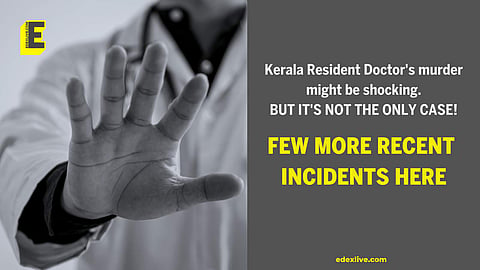

Dr Rahul Nair, a Nephrology Resident at Nizam Institute of Medical Sciences (NIMS) in Hyderabad, was assaulted and surrounded by a group of approximately 20 individuals today, May 11. The incident occurred while he was attending to a 62-year-old patient suffering from Chronic Kidney Disease, who unfortunately passed away at midnight. The patient's relatives attacked Dr Rahul in response to the patient's demise.
The recent tragic killing of Dr Vandana Das, a 23-year-old doctor working in a government hospital in Kollam district, Kerala, has triggered a significant outcry within the medical community in India. Both the Kerala Government Medical Officers Association and the Indian Medical Association (IMA) have declared their decision to refrain from performing their duties in the state, except in cases of emergency. Doctors across the nation have taken to the streets, demanding that the government take necessary measures to ensure the safety of healthcare professionals.
On January 6, two junior doctors at Shri Vasantrao Naik Government Medical College in Maharashtra's Yavatmal district were attacked by a patient with a fruit cutter. The patient, who was being treated for self-inflicted stab wounds, attacked one doctor when he was on rounds, and attacked the other doctor when he came to the rescue of the former.
These incidents are just three among many instances of violence against young healthcare workers, which have seen an alarming rise in the last few years.
According to an article by Aatmika Nair and Siddhesh Zadey published in The Lancet in August 2022, “from 2016 to date, India saw a total of 220 reported Violence Against Healthcare Workers (VAHCW) incidents contributing to 3.4% of the global incidents, though India contributes to less than 1% of the global Healthcare Workers.”
An ongoing survey by the IMA revealed that over 75% of the doctors in India have faced some form of violence, and over 68% of the violence has been perpetrated by escorts and/or relatives of the patients.
This was especially evident during the COVID-19 pandemic when frontline healthcare workers, dubbed “COVID Warriors” by the Central Government, were subject to violence from the patients’ kin and attendants.
For example, in 2021, a young doctor working in a COVID care centre in Assam was attacked by the relatives of a patient who succumbed to the virus under his care. The video of the incident, which saw the relatives hitting the doctor’s head with a headpan, hurling chairs, and abusing the hospital staff, garnered widespread protest from the medical fraternity after it went viral.
Similarly, in 2020, a third-year post-graduate student who was serving as a junior resident doctor at NIMS, Hyderabad was attacked after a 55-year-old patient in his treatment died of respiratory failure. This was after the patient removed his oxygen mask to use the bathroom, despite being advised against it. The patient’s attendants attacked the Junior Resident with a plastic chair and an iron stool after being aware of what happened. This incident, and other similar incidents at NIMS, led to a protest by around 300 junior doctors in the city.
This is not to say that there have not been incidents of violence against doctors before the pandemic.
In June 2019, two junior resident doctors at the Nil Ratan Sircar Medical College and Hospital (NRSMCH) were reportedly assaulted by the relatives of a 75-year-old patient, who passed away at the hospital. The two interns, who were dealing with the protesting relatives, sustained deep injuries on their heads.
Following this incident, 50 intern doctors at NRSMCH closed the gates of the hospital to protest against the assault and the West Bengal Doctors’ Forum proposed to stop their work at all outpatient facilities at government-run hospitals. The doctors also demanded that West Bengal Chief Minister Mamta Banerjee takes the necessary steps to ensure patient safety.
This agitation also spilled over to other state-run medical colleges in the state and the medical community in India at large, with more than 700 doctors from West Bengal resigning, and the Indian Medical Association calling for a nationwide protest.
An article published in the Indian Heart Journal by Paurush Ambaresh, titled “Violence against doctors in the Indian subcontinent: A rising bane,” attributes the violence against healthcare workers to the demonisation of doctors by the Indian Media, low doctor-patient ratios in government hospitals, the diminishing trust in the doctor-patient relationship, a lack of proper redressal systems for patients, and medical services becoming inaccessible to the common man.
Another reason behind the increasing attacks against healthcare workers, especially junior residents, is a lack of protection from the law. In 2020, the Indian Government enacted the Epidemic Diseases (Amendment) Act (2020), which punishes perpetrators of violence against healthcare workers with 3 months to 5 years of imprisonment, as well as a fine of Rs. 50,000 to Rs. 2 Lakhs. However, this amendment would be dissolved once the pandemic was declared over, making it a temporary respite.
In addition, several states and union territories in India have passed the Medical Protection Act (or some variation of it), which makes attacks against doctors and hospital property an offense punishable by imprisonment and a fine. However, this act is not featured in the Indian Penal Code or the Code of Criminal Procedure – and fails to protect doctors.
